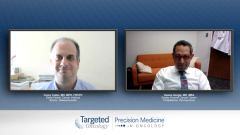
Practical Advice for Implementing the REACH2 Regimen
Key opinion leaders provide community oncologists with advice for implementing the REACH2 regimen to manage patients with acute graft-vs-host disease (GVHD).
Episodes in this series

Corey Cutler, MD, MPH, FRCPC: Do you have any pearls or anything special about the use of this drug that you’d like to share?
Usama Gergis, MD, MBA: Sure. I want to share 3 points. I’m not sure if they’re pearls, but they’re points. No. 1 is the time to response for ruxolitinib is about a week. This is very important because most of these patients will probably end up dying from acute graft-vs-host disease [GVHD].
Corey Cutler, MD, MPH, FRCPC: And infection.
Usama Gergis, MD, MBA: Right. As a primary cause, and then infections, so it’s very important for us to have that number. It’s not that if your patient is not responding by a week, but you probably should be nudged to be prepared to do something else. So it’s a week.
The second has to do with platelets and this comes from MPN [myeloproliferative neoplasm] [Research Foundation] trials in myelofibrosis. Most patients with acute GVHD will probably have low platelets—not necessarily very low, but around 50s. There are many mechanisms for that. When I first came to my new institution [Sidney Kimmel Cancer Center], there was some resistance to start drugs in people with platelets of 50 per mm3. From my previous experience, we start to give it, and the platelets would go down. But most of the time it will plateau. It will not keep on going down to less than 10 per mm3,and you start transfusing every day. It will probably plateau around 30s or 25 per mm3, but you still have acute graft-vs-host disease and many other mechanisms. In my opinion, the platelets management in acute GVHD is way more complicated than in myelofibrosis.
Corey Cutler, MD, MPH, FRCPC: Is there a level of thrombocytopenia below which you will not start ruxolitinib? What’s your threshold?
Usama Gergis, MD, MBA: I don’t think there are any data. My data are depending on how bad the acute GVHD is. As I mentioned, there is no level. I’ll get nervous if [platelets are] less than 10,000 per mm3, and obviously these patients will be hospitalized. If I have someone who has acute GVHD and is steroid refractory, grade 4, and I think that ruxolitinib is a good drug and their platelets are 9000 per mm3, I’ll give them platelets and go on.
Corey Cutler, MD, MPH, FRCPC: I’m a little more cautious. I try not to start ruxolitinib when the platelets are below 20,000 per mm3 or so. Above that, I’m pretty cavalier. Below 20,000 I get a little nervous—particularly because these patients often have GI [gastrointestinal] involvement and they tend to bleed. Being really careful about platelet counts is 1 of the important things to consider when we’re dealing with this. But you’re right, transfusions work, and being proactive in taking care of the prothrombin time and the INR [international normalized ratio] in case the patients are very malnourished is 1 way to prevent real bleeding issues.
Transcript edited for clarity.










































